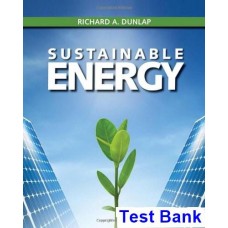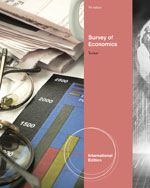Sustainable Energy 1st Edition By Richard Dunlap – Test Bank
$25.00
Edition: 1st Edition
Format: Downloadable ZIP File
Resource Type: Test Bank
Duration: Unlimited downloads
Delivery: Instant Download
Sustainable Energy 1st Edition By Richard Dunlap – Test Bank
Chapter 4
Environmental Consequences
of Fossil Fuel Use
4.1 If one tonne of coal is burned and the CO2 that is produced is sequestered by reaction with CaO as CaO + CO2 → CaCO3. What is the mass of CaO that will be required? Assume coal is pure carbon.
Solution The combustion process is
C + O2 → CO2
The relevant molecular masses are
C → 12 g/mol
so burning 12 g of carbon yields 44 g of CO2 and 44 g of CO2 will require 56 g of CaO for sequestration. This means that burning 1 tonne of carbon will require
(1 t) × (44 g/12 g) × (56g/44g) = 4.67 t of CaO for sequestration.
4.2 Phobos, the largest moon of Mars, is at a mean distance from the sun of 1.52 times that of the Earth. It has a very low estimated albedo of ~0.1. Calculate its temperature.
Solution The total power absorbed by a body with an albedo of a and an insolation of S is
Pabsorbed = (1 –- a)S πR2.
The power radiated by a black body at a temperature T is
Pradiated = 4πR2σT4
Equating these gives the equilibrium condition for a planet without atmosphere at a temperature given by
where σ is the Stefan Boltzmann constant. The insolation on the earth (outside the atmosphere) is 1.367 kW/m2 so at the distance of Phobos the 1/r2 law gives the insulation as
The temperature is
T = {[(1 –- 0.1) × 592 W/m2]/[4 × 5.67 × 10–-8 Wm–-2K–-4}1/4 = 220 K
Note: the actual measured average temperature is 233 K.
4.3 A 1600 kg gasoline-powered vehicle requires 3.5 MJ of primary energy to travel 1 km (note: The properties of gasoline may be approximated as the properties of octane C8H18, which has the energy of combustion of 44.4 MJ/kg). If the vehicle travels a total of 300,000 km during its life, what is the ratio of the mass of the CO2 emitted to the mass of the vehicle?
Solution 300,000 km will require energy. This requires a total gasoline consumption over the life of the vehicle of
(1.05 × 106 MJ)/(44.4 MJ/kg) = 2.36 × 104 kg
Octane is C8H18 and the oxidation process is
in terms of the molecular mass
so the combustion of 2 × 114g = 228g of octane yields 16 × 44 = 704g of CO2 so the combustion of 2.36 × 104 kg of gasoline will produce
(2.36 × 104 kg) × (704 g/228 g) = 7.29 × 104 kg
That is about 46 times the mass of the vehicle itself.


MAECENAS IACULIS
Vestibulum curae torquent diam diam commodo parturient penatibus nunc dui adipiscing convallis bulum parturient suspendisse parturient a.Parturient in parturient scelerisque nibh lectus quam a natoque adipiscing a vestibulum hendrerit et pharetra fames nunc natoque dui.
ADIPISCING CONVALLIS BULUM
- Vestibulum penatibus nunc dui adipiscing convallis bulum parturient suspendisse.
- Abitur parturient praesent lectus quam a natoque adipiscing a vestibulum hendre.
- Diam parturient dictumst parturient scelerisque nibh lectus.
Scelerisque adipiscing bibendum sem vestibulum et in a a a purus lectus faucibus lobortis tincidunt purus lectus nisl class eros.Condimentum a et ullamcorper dictumst mus et tristique elementum nam inceptos hac parturient scelerisque vestibulum amet elit ut volutpat.













Reviews
There are no reviews yet.